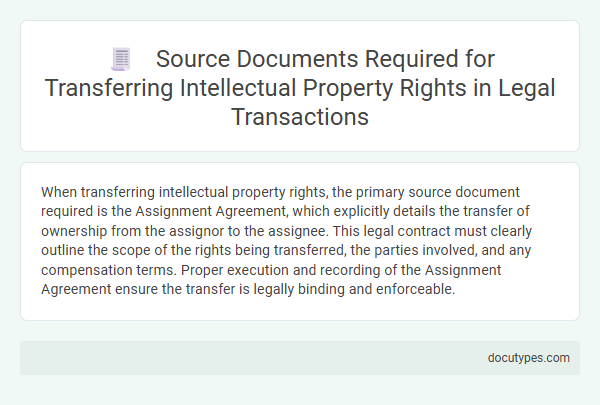When transferring intellectual property rights, the primary source document required is the Assignment Agreement, which explicitly details the transfer of ownership from the assignor to the assignee. This legal contract must clearly outline the scope of the rights being transferred, the parties involved, and any compensation terms. Proper execution and recording of the Assignment Agreement ensure the transfer is legally binding and enforceable.
Introduction to Source Documents in IP Transfers
Transferring intellectual property rights requires precise documentation to ensure legal validity and clear ownership. Source documents are essential to establish the origin and scope of the rights being transferred.
- Assignment Agreement - A legal contract that formally transfers IP ownership from the assignor to the assignee.
- License Agreement - Defines the terms under which IP rights are granted for use without transferring ownership.
- IP Registration Certificates - Official documents that prove the existence and registration of the intellectual property involved.
You must have the correct source document to protect your rights during an intellectual property transfer.
Importance of Proper Documentation in Legal IP Transactions
Proper documentation is essential when transferring intellectual property rights to ensure clear ownership and avoid future legal disputes. The source document, such as an assignment agreement or licensing contract, provides the legal basis for the transfer and specifies the terms and conditions. You must retain these documents to protect your rights and verify the authenticity of the transaction in any potential legal proceedings.
Types of Intellectual Property Requiring Source Documents
When transferring intellectual property rights, the required source document depends on the type of intellectual property involved. Each category, such as patents, trademarks, copyrights, and trade secrets, demands specific documentation to validate the transfer.
For patents, an assignment agreement must be provided to record the transfer of ownership. Trademarks require a similar assignment document, often filed with the appropriate government agency to update registration details.
Essential Source Documents for IP Assignment
When transferring intellectual property rights, specific source documents ensure the legal validity and clarity of the assignment. These documents detail the terms, parties involved, and scope of the rights being transferred.
- Assignment Agreement - This primary document formally records the transfer of IP rights from the assignor to the assignee.
- Proof of Original Ownership - Documentation such as registration certificates or prior agreements verifies the assignor's legal ownership of the intellectual property.
- Consent or Authorization Letters - These are required if the IP rights are jointly owned or involve third-party permissions to confirm all necessary approvals for the transfer.
Mandatory Agreements in IP Right Transfers
When transferring intellectual property rights, a legally binding assignment agreement is essential. This document clearly outlines the transfer of ownership from the assignor to the assignee, ensuring all rights are properly conveyed.
Confidentiality agreements may be required to protect sensitive information during the transfer process. You must also consider any licensing contracts or consent forms that support the primary assignment agreement in the transfer of IP rights.
Supporting Evidence and Proof of Ownership
When transferring intellectual property rights, the source document serves as crucial supporting evidence and proof of ownership. It ensures clear legal verification of the transfer and prevents future disputes.
- Assignment Agreement - This document formally records the transfer of intellectual property rights from the original owner to another party.
- Certificates of Registration - Official certificates issued by patent or trademark offices serve as undeniable proof of ownership.
- Prior Licensing or Purchase Contracts - These contracts demonstrate previous agreements and ownership history relevant to the intellectual property.
Due Diligence Documentation Checklist
| Source Document | Purpose | Key Details to Verify | Importance in IP Transfer |
|---|---|---|---|
| Assignment Agreement | Formalizes the transfer of intellectual property rights from one party to another. | Parties involved, scope of rights assigned, effective date, and signatures. | Primary legal document validating the ownership transfer and preventing future disputes. |
| License Agreements | Details any licenses granted related to the IP prior to transfer. | Terms of use, exclusivity, license fees, and duration. | Clarifies existing rights and restrictions affecting the IP. |
| Proof of Ownership | Demonstrates original ownership and registration of the intellectual property. | Patent certificates, trademark registrations, copyright certificates. | Confirms the transferor's right to transfer the IP and its validity. |
| Due Diligence Documentation Checklist | Ensures comprehensive verification of all IP-related documents. | List of all IP assets, contracts, encumbrances, litigation history, and compliance status. | Helps you identify potential risks or gaps before finalizing the transfer. |
| Employment and Contractor Agreements | Establishes ownership rights of IP created by employees or contractors. | IP assignment clauses, confidentiality terms, and work-for-hire provisions. | Ensures clear chain of title and prevents future claims on transferred IP. |
| Confidentiality Agreements | Protects proprietary information exchanged during negotiations. | Scope of confidentiality, duration, and permitted disclosures. | Maintains secrecy and safeguards sensitive business information involved in the IP transfer. |
Common Legal Pitfalls in IP Transfer Documentation
Which source document is essential when transferring intellectual property rights? The primary document required is a well-drafted Intellectual Property Assignment Agreement. This document must clearly outline the scope of rights transferred to avoid common legal pitfalls such as ambiguous terms or missing signatures.
International Considerations for IP Source Documents
When transferring intellectual property rights internationally, the source document must clearly outline the scope and jurisdiction of the transfer. Key documents include assignment agreements, licensing contracts, and notarized declarations that comply with the laws of the involved countries.
Your IP transfer requires meticulously drafted source documents that address the specific international legal frameworks, such as the Berne Convention or the TRIPS Agreement. These documents ensure recognition and enforceability across borders. Verification by legal experts in both jurisdictions helps prevent disputes and safeguards your intellectual property rights globally.
Which Source Document Is Needed When Transferring Intellectual Property Rights? Infographic

